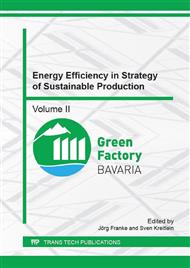p.99
p.109
p.117
p.123
p.131
p.143
p.151
p.159
p.166
Simulation Based Studies of Energy Saving Measures in the Aluminum Tool and Die Casting Industry
Abstract:
This study, which focuses on analyzing aluminum melting and die casting procedures is part of the Smart Melting project in the research network Green Factory Bavaria (GFB). The aim of the present research project is to investigate these procedures and to suggest measures to increase the overall energy efficiency. The analysis starts with the capture of the operating structure, the relations between supply and consumption of liquid aluminum and an evaluation of aluminum furnaces themselves. The study concentrates on shaft furnaces whose specific energy consumption is 25 % higher than stated by the manufacturers. At the same time the melting capacity of the furnaces ranges at the lower end according to the manufacturer's data. The reason for this deviation is a discontinuous operation mode due to demand fluctuations. Consequently the flue gas has still a high temperature which means a high waste of energy. Based on these facts the furnace charge and operation mode have to be optimized and the high temperature flue gas can be used to preheat the pig aluminum.A numerical model of aluminum furnaces is applied to investigate this optimization potential. This model can simulate either a single aluminum furnace (case 1) or a furnace integrated in the entire manufacturing plant (case 2). The advantage of case 1 is the furnace's operation on its most efficient point because there is no influence of the die casting process. In case 1 an improvement of the furnace charge leads to a higher capacity utilization and therefore to a reduction of 30 % specific energy consumption and a 50 % increase of melting capacity. Whereas in case 2 the simulation of the entire manufacturing plant results in a rise of 25 % melting capacity and a 16 % decrease of specific energy consumption. The simulation proved increasing energy efficiency due to preheating the pig aluminum in both cases.
Info:
Periodical:
Pages:
131-139
Citation:
Online since:
November 2016
Authors:
Price:
Сopyright:
© 2017 Trans Tech Publications Ltd. All Rights Reserved
Share:
Citation:


